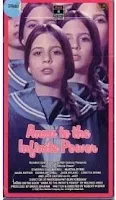--------
Producer Guillermo Del Toro and Director/Writer Vincenzo Natali's latest movie is Splice, which stars Adrien Brody and Sarah Polley as a pair of molecular biologists with more ambition than sense.
Elsa and Clive, two young rebellious scientists, defy legal and ethical boundaries and forge ahead with a dangerous experiment: splicing together human and animal DNA to create a new organism. Named "Dren", the creature rapidly develops from a deformed female infant into a beautiful but dangerous winged human-chimera, who forges a bond with both of her creators - only to have that bond turn deadly.Nelson Cabral of Bloody-Disgusting.com interviewed Natali, whose description of the main characters makes them sound a bit like computer hackers:
. . . I sort of saw it as the natural evolution of whats happening with computer programming. A lot of really young people do computer programming, they deal with really sophisticated technology, really sophisticated hardware. I’m sure that that is happening currently in the bio-technology field as well. It just seemed like the appropriate thing. On some level, the movie is about deciding to have a family, and what you do with becoming a parent, so it had to be about young people so Clive and Elsa are sort of, as rock and roll geneticists, are ill equipped to become parents, and that’s what makes it exciting to watch them have a mutant kid.Natali also mentioned the real science that was his inspiration for the movie:
Why splice? Because years ago there was this thing I saw a photo of, its called (something)mouse, it was, by all appearances, a human ear on its back. It actually was a plastic armature under a kind of skin that could be grafted onto human beings. It was such a crazy, shocking weird image that I was inspired to write a story about genetic splicing.
 The experiment that Natali is remembering is probably the work of Joseph and Charles Vacanti of the Tissue Engineering & Organ Fabrication Laboratory at Massachusetts General Hospital. Back in 1997 their photo of a mouse with a human ear-shaped growth on its back made a splash in the popular media. It's no wonder that it caught Natali's attention. He apparently didn't pay much attention to the story attached with the picture, though, because the experiment had absolutely nothing to do with genetic engineering. What the Vacantis and colleagues actually did was form a biodegradable polymer into the shape of a human ear, seed it with cow cartilage cells (bovine chondrocytes), and implant it under the skin of the experimental mice1. They found that new cartilage formed in the shape of the implant. And it turns out their methodology had immediate real-world applications. They used similar techniques to grow a "shield" in the chest of boy who was born with no cartilage or bone between his skin and heart. They also were able to grow a replacement thumb tip using a scaffold made of coral. It's very cool tissue engineering technology.
The experiment that Natali is remembering is probably the work of Joseph and Charles Vacanti of the Tissue Engineering & Organ Fabrication Laboratory at Massachusetts General Hospital. Back in 1997 their photo of a mouse with a human ear-shaped growth on its back made a splash in the popular media. It's no wonder that it caught Natali's attention. He apparently didn't pay much attention to the story attached with the picture, though, because the experiment had absolutely nothing to do with genetic engineering. What the Vacantis and colleagues actually did was form a biodegradable polymer into the shape of a human ear, seed it with cow cartilage cells (bovine chondrocytes), and implant it under the skin of the experimental mice1. They found that new cartilage formed in the shape of the implant. And it turns out their methodology had immediate real-world applications. They used similar techniques to grow a "shield" in the chest of boy who was born with no cartilage or bone between his skin and heart. They also were able to grow a replacement thumb tip using a scaffold made of coral. It's very cool tissue engineering technology.It isn't that surprising that Natali thinks that genetic engineering was involved. He may have seen the full page ad in the New York Times placed by the anti-biotechnology group the Turning Point Project, which (according to Wikipedia) showed the picture of the ear-bearing mouse with the description "This is an actual photo of a genetically engineered mouse with a human ear on its back"2. The image also made the email chain letter rounds with similarly misleading information.
I've noticed that the term "mutant" is commonly used as shorthand to describe any mal- or unusually-formed animal, even when no mutations or other DNA changes are involved, so it's not such a stretch for people to believe that genetic engineering could be used for something as fantastic as growing an extra ear. Splice taps into the idea that genetic engineering is the can-do-anything science for the 21st century. As Splice co-producer Steve Hoban commented, “If Mary Shelley had been born 200 years later she wouldn’t have written Frankenstein, she would have written ‘Splice’.
Splice is scheduled to be released in 2009. In the mean time, check out Ain't It Cool News for more images of Splice's human-animal hybrid (some NSFW).
1. Cao Y et al. (1997) "Transplantation of Chondrocytes Utilizing a Polymer-Cell Construct to Pruduce Tissue-Engineered Cartilage in the Shape of a Human Ear", Plast Reconstr Surg 100(2):297-302.
2. It's not clear to me if their deception was intentional or the creator of he ad was merely incompetent. Unfortunately advertisements aren't required to be truthful (or issue corrections for inaccuracies), so public perception is influenced by the misleading copy.
Tags:tissue engineering, Tags:genetic engineering,Vincenzo Natali,Splice
























